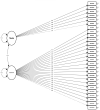Validation of a Brief Measure for Complicated Grief Specific to Reproductive Loss
- PMID: 37214013
- PMCID: PMC10199718
- DOI: 10.7759/cureus.37884
Validation of a Brief Measure for Complicated Grief Specific to Reproductive Loss
Abstract
Objective Complicated grief reactions follow some pregnancy outcomes, like miscarriage, stillbirth, neonatal death, infant death, selective reduction, or termination of pregnancy. Stigma can delay treatment and worsen outcomes. Screening tools such as the Edinburgh Postnatal Depression Scale detect complicated grief poorly, and specific tools for prolonged or complicated grief after a reproductive loss are cumbersome. In this study, a five-item questionnaire to detect complicated grief after reproductive loss of any type was designed and preliminary validated. Methods A questionnaire patterned after the extensively validated Brief Grief Questionnaire (BGQ) was created by a group of physicians and lay advocates to employ non-traumatic but specific language related to grief after miscarriage, stillbirth, neonatal death, infant death, selective reduction, or termination of pregnancy. One hundred and forty women at a large academic center were recruited in person and via social media to validate the questionnaire with well-studied instruments for anxiety (7-item Panic Disorder Severity Scale, PDSS), trauma (22-item Impact of Events Scale), and reproductive grief and depressive symptoms (33-item Perinatal Grief Scale [PGS]). Results The response rate was 74.9%. Of the 140 participants, 18 (12.8%) experienced their loss during high-risk pregnancies, and 65 (46.4%) were recruited via social media. Seventy-one (51%) respondents had a score > 4, a positive screen for the BGQ. On average, women experienced their loss 2 years prior to participation (IQR 1-5 years). Cronbach's alpha was 0.77 (95% CI: 0.69-0.83). The goodness of fit indices of the model met Fornell and Larker criteria (RMSEA = 0.167, CFI = 0.89, SRMR = 0.06). The AVE was 0.42 and the CR 0.78. Conclusions This investigator-created screening tool is internally consistent and meets preliminary criteria for discriminant validity. This tool can be refined prior to testing for sensitivity and specificity in screening for complicated grief after a reproductive loss.
Keywords: abortion; miscarriage; neonatal death; persistent complex bereavement disorder; postpartum depression; pregnancy loss; prolonged grief; screening; stillbirth; survey.
Copyright © 2023, Buskmiller et al.
Conflict of interest statement
The authors have declared that no competing interests exist.
Figures



Similar articles
-
Hindi translation and validation of perinatal grief scale (short version): Assessing grief following stillbirth in bereaved mothers.Indian J Psychiatry. 2025 Feb;67(2):229-235. doi: 10.4103/indianjpsychiatry.indianjpsychiatry_631_24. Epub 2025 Feb 19. Indian J Psychiatry. 2025. PMID: 40181878 Free PMC article.
-
Complicated grief after perinatal loss.Dialogues Clin Neurosci. 2012 Jun;14(2):187-94. doi: 10.31887/DCNS.2012.14.2/akersting. Dialogues Clin Neurosci. 2012. PMID: 22754291 Free PMC article. Review.
-
Predicting grief intensity after recent perinatal loss.J Psychosom Res. 2017 Oct;101:128-134. doi: 10.1016/j.jpsychores.2017.07.016. Epub 2017 Aug 2. J Psychosom Res. 2017. PMID: 28867418
-
Evaluation of the perinatal grief intensity scale in the subsequent pregnancy after perinatal loss.J Obstet Gynecol Neonatal Nurs. 2013 Nov-Dec;42(6):697-706. doi: 10.1111/1552-6909.12249. Epub 2013 Oct 15. J Obstet Gynecol Neonatal Nurs. 2013. PMID: 24128062
-
A systematic review of instruments measuring grief after perinatal loss and factors associated with grief reactions.Palliat Support Care. 2021 Apr;19(2):246-256. doi: 10.1017/S1478951520000826. Palliat Support Care. 2021. PMID: 32867873
Cited by
-
Complicated grief following the perinatal loss: a systematic review.BMC Pregnancy Childbirth. 2024 Nov 22;24(1):772. doi: 10.1186/s12884-024-06986-y. BMC Pregnancy Childbirth. 2024. PMID: 39578811 Free PMC article.
References
-
- ACOG Practice Bulletin No. 200: early pregnancy loss. Obstet Gynecol. 2018;132:0–207. - PubMed
-
- Obstetric care consensus #10: management of stillbirth: (replaces practice Bulletin Number 102, March 2009) Metz TD, Berry RS, Fretts RC, Reddy UM, Turrentine MA. Am J Obstet Gynecol. 2020;222:0. - PubMed
-
- Mortality in the United States. Murphy SL, Kochanek KD, Xu J, Arias E. NCHS Data Brief. 2021;427:1–8. - PubMed
-
- Evaluation of symptoms of anxiety and depression in patients with a miscarriage. Ambriz-López R, Guerrero-González G, Rodríguez-Valero CG, Treviño-Montemayor OR, Guzmán-López A, Saldívar-Rodríguez D. Med Univ. 2017;19:7–12.
LinkOut - more resources
Full Text Sources
Miscellaneous
